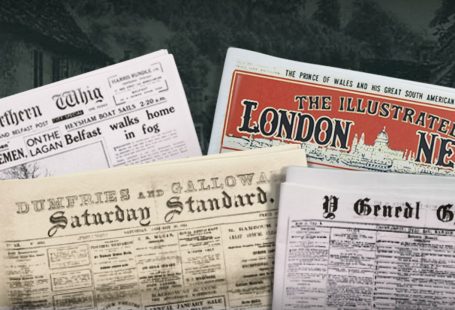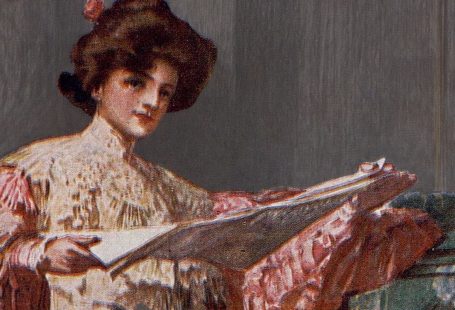This week at The Archive we are celebrating reaching the fantastic milestone of 50 million pages – all now available to search. When The Archive was launched over 10 years ago we could not have dreamed of reaching this incredible figure, and we’re not stopping here. Expect to see millions more pages joining our collection over the next months and years, with exciting new titles joining us from across the United Kingdom and Ireland, and beyond.
Find out more about this wonderful milestone, as well as to discover 50 fabulous things about The Archive in our special blog.
And pushing us just over the edge of that magical 50 million mark are the 119,656 brand new pages we have added over the last seven days. Meanwhile, we are delighted to welcome three brand new titles this week from Kent, Suffolk and Yorkshire. Meanwhile, we have updated six of our existing titles, with additions to titles from Wales, Pakistan and England, as well as a specialist temperance publication.
So read on to discover more about all of our new and updated titles of the week, as well as to learn all about some historic Easter traditions, from mystery plays to special charity cakes.
Register now and explore the Archive
We begin our foray into our trio of new titles this week with a look at the Cleveland Standard, which was first published in Redcar in 1908. Published every Friday, and circulating ‘throughout the Cleveland district,’ which covers an area of hills and dales from the River Tees to the Vale of Pickering, as well as part of the North Yorkshire moors, the Cleveland Standard cost just one penny.
Containing an array of international and national news, alongside selected local news from Redcar, Loftus, Saltburn, Guisborough, Shelton and Brotton, as well as from the Guisborough Police Court, and organisations like the Cleveland Miners’ Union and Wilton Parish Church, the Cleveland Standard was a lively and thorough news chronicle. And alongside such news articles, the newspaper also featured ‘Hints for the Home,’ which gave advice on matters like baldness and one’s complexion, as well as recipes for ‘nice dishes’ like barbequed oysters, and a column dedicated to children, entitled ‘Something For Young Folks.’

Meanwhile, the Cleveland Standard contained illustrations in a section called ‘My Sketch Book,’ which featured depictions of personalities of the day and current exhibitions. Meanwhile, further illustrations were published in a column entitled ‘Dress-Making At Home With Sylvia,’ which contained drawings of outfits and diagrams of the patterns needed to make them. Finally, the Cleveland Standard also detailed the latest local sports results, and published serialised fiction.
It’s to Suffolk we turn for our next new title of the week, which is the historic Woodbridge Reporter. An independent title that was established in 1859, it circulated ‘throughout a large and populous agricultural district’ of east Suffolk that surrounded the port and market town of Woodbridge, which lies seven miles north east of Ipswich.

Appearing every Thursday at the cost of one pence, and filling eight pages, the Woodbridge Reporter featured international news, for example looking at ‘Changes For The Better In Japan,’ and national news, with articles like ‘Drinking Fountains and Cattle Troughs In London.’ Meanwhile, the newspaper contained all the news from the district, from the likes of Melton and Ipswich, as well as from the local petty sessions and police courts. An important guide to the area, the Woodbridge Reporter published a ‘List of Visitors’ to the area, as well as notices of marriages and deaths.
In 1892, over thirty years after its first appearance, the newspaper changed its named to the Woodbridge Reporter and Wickham Market Gazette.
Our final new title of the week hails from Kent, and is the Tonbridge Free Press. Originally known as the Tonbridge Free Pres, and Mid Kent Advertister, Tunbridge Wells, Southboro’, Sevenoaks, Hildenboro,’ and Hadlaw News, this Liberal newspaper was first published in the Kent market town of Tonbridge, which lies on the River Medway, in 1869. Circulating in ‘Tonbridge, and South West Kent generally,’ the publication cost one pence and appeared every Saturday.

Filling four pages, the Tonbridge Free Press contained ‘Local Notes’ from the likes of Southborough, Lamberhurst, Tunbridge Wells, Chislehurst, Maidstone and Plaxtol, as well as reporting on the Kent Assizes. The newspaper also published original poetry, ‘Foreign Intelligence,’ the latest from London, as well as notices of births, marriages and deaths.
Meanwhile this week we have also updated six of our existing titles. Highlights include the two Welsh newspaper titles to which we have made updates, the Rhos Herald and Y Llan, the latter being one of our Welsh language titles. We have also made significant updates to one of our international titles, the Civil & Military Gazette (Lahore). Furthermore, we have added new pages to our Victorian temperance title the Alliance News, which was the organ of the United Kingdom Alliance For The Suppression Of The Traffic In All Intoxicating Liquors.
Historic Easter Traditions
With the Easter Bank Holiday weekend approaching in the United Kingdom, we delved into our new newspapers to discover more about Easter traditions from the past, and they didn’t disappoint. Without any further ado, here are three Easter traditions from the past that you may not know about.

1. Mystery Plays
In March 1920 the Tonbridge Free Press reported how the ‘Tonbridge Guild of Players will make their first appearance in an Easter Mystery Play.’ The newspaper went on to outline for its readers exactly what a ‘mystery play’ consisted of:
The plays were always produced under ecclesiastical authority, and were designed to emphasise or illustrate some aspect of Christian teaching. They were also known as Morality Plays, or Moralities. They were always performed in open air, often at the abbey or church gates.

Popular during the Medieval period, an Easter mystery play would concentrate on the events of Easter, although historically such plays did not always adhere to the Christian tradition, as relates the Tonbridge Free Press:
Some of the plays were grotesque in the extreme, characters being introduced in disguises intended to represent the devil, demons, ogres, and even giants. The strictly religious intent was occasionally made subsidiary to purely secular interest, local folk lore and tradition being introduced wholly or in part. But such perversions were not legitimate, and occasionally were the subject of ecclesiastical censure and amendment.
Meanwhile, actors in mystery plays had ‘no scenery‘ from which to benefit, having to ‘create their effect by words and costumes.’
The members of the Tonbridge Guild of Players, therefore, during Easter 1920, were resurrecting a centuries’ old tradition, whilst another ancient Easter tradition was being kept to, also in Kent, in the Victorian era and beyond.
2. The Biddenden Maids
The Woodbridge Reporter in April 1881 details some interesting Easter customs, including the distribution of ‘Biddenden maids’ cakes’ at the village of Biddenden, near Staplehurst, in Kent. The newspaper reports how:
Immediately at the close of the afternoon service on Easter Day, by an endowment of old but unknown date, a distribution of ‘Biddenden maids’ cakes’ takes place. The applicants for the charity proceed to the old workhouse, erected on the bread-and-cheese land, within five minutes’ walk of the church, where the two churchwardens distribute a three-pound loaf of bread with about a pound of cheese to each person entitled to the gift. Memorial cakes, with the effigies of the Biddenden maids, are freely given to all applications.

But who exactly were the Biddenden maids, and from where did the custom originate? The Woodbridge Reporter was on hand to explain:
About the year 1100 there lived Eliza and Mary Chulkhurst, who were joined together after the manner of the Siamese twins, and who lived for thirty-four years, one dying, and then being followed by her sister in six hours. By their will, it is said, they left certain lands to be devoted to the purpose of supplying the charity already described, their memories perpetuated in their effigies being imprinted on the cakes ‘in their habit as they lived.’
These lands were known as the ‘bread and cheese lands,’ and the cakes, as reported the Woodbridge Reporter in 1873, nearly 10 years before the newspaper again outlined the curious tradition, were made from ‘simple flour and water,’ being ‘four inches long by two inches wide.’ 300 were given away each year, ‘at the discretion of the churchwardens,’ whilst the:
…impressions of the ‘maids’ on the cakes are of primitive character, and made by boxwood die cut in 1814. They bear the date 1100, when Eliza and Mary Chulkhurst are supposed to have been born, and also their ages at death, thirty-four years.

The cakes were ‘much sought after as curiosities’ during this period, and the Woodbridge Reporter details how the giving of the cakes used to take place in the church, a practice which was discontinued ‘in consequence of the unseemly disturbance which used to ensue.’ The newspaper explains how:
The church used to be filled with a congregation whose conduct was occasionally so reprehensible that sometimes the churchwardens had to use their wands for other purposes than as symbols of office.

In light of this shocking behaviour, the Archbishop had to intervene, the distribution of the cakes taking place at the poorhouse on the bread and cheese lands.
Meanwhile, in Twickenham, the distribution of bread in church at Easter time had to be halted for similar reasons, as details the Woodbridge Reporter in 1881:
…at Twickenham, on Easter Day, two great cakes were divided in church among the young people, but this custom was discontinued in the year 1645, on the account of the unseemly scenes it annually produced, and loaves of bread were purchased instead for the poor of the parish. At one time these were thrown from the church steeple, to be scrambled for on the Thursday before Easter, a custom which also prevailed at Paddington.
3. Chipping The Block
Our final intriguing Easter custom comes from University College, Oxford, and was also detailed by the Woodbridge Reporter in 1881. This tradition was known as ‘chipping the block,’ which entailed a block, ‘in the form of long wooden pole, decorated with flowers and ever-greens,’ being placed outside of the door of the college’s hall.

Standing next to the block was the college’s cook and the attendant, one of whom carried a pewter dish, and the other held an axe. And so:
As the members of the college came out of the hall each took the axe, and struck the block with it, and then placed in the pewter dish the usual fee to the cook; the master’s fee being half a guinea, and that of the fellows five shillings and sixpence.
Tradition dictates that ‘anyone who could chop the block in two’ could ‘lay claim to the college estates.’ Whether anybody was successful in such a claim, tradition does not relate!
New Titles
Title | Years Added |
| Cleveland Standard | 1908-1953 |
| Tonbridge Free Press | 1871-1890, 1892-1894, 1896, 1898, 1900-1962 |
| Woodbridge Reporter | 1869-1900 |
Updated Titles
This week we have updated six of our existing titles.
You can learn more about each of the titles we add to every week by clicking on their names. On each paper’s title page, you can read a FREE sample issue, learn more about our current holdings, and our plans for digitisation.
Title | Years Added |
| Alliance News | 1855, 1884 |
| Bury Free Press | 1960-1961, 1963-1966, 1971 |
| Civil & Military Gazette (Lahore) | 1929, 1935-1938, 1946-1947, 1951, 1955-1961 |
| Leek Times | 1887 |
| Rhos Herald | 1894-1897, 1899-1909 |
| Y Llan | 1870-1873, 1875-1881 |
You can keep up to date with all the latest additions by visiting the recently added page. You can even look ahead to see what we’re going to add tomorrow.







